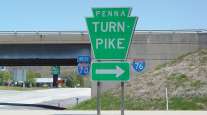Roads That Pay for Themselves: Startup Nears Two Smart Pavement Pilot Project Contracts

After years of planning, the next several months are when Tim Sylvester will get the chance to start testing out what he’s been telling people for years: roads can pay for themselves.
Sylvester’s company, Integrated Roadways, wants to put sensors, phone and Internet connectivity and other hardware inside the surfaces society drives on. The company has been pitching the idea to governments since 2012, but unlike the nimble cloud startups that have flared in and out of existence in the interim, Integrated Roadways is dealing in one of the heaviest kinds of hardware possible for a tech company to lift. So until now, it’s been limited to exploring the idea in partnership with governments who might want to put high-tech roads in place in the future.
Finally, it has two pilot projects coming up where it intends to actually lay down pavement and prove its concept: One in Kansas City, Mo. and one in another state. Bob Bennett, Kansas City’s chief innovation officer, confirmed the location of the first pilot. Sylvester has yet to announce the location of the second.
Sometime this month, Sylvester expects to formally enter into contracts with both state agencies involved to lay down a combined 1.5 miles of pavement. He expects construction to begin in the spring, and to finish around August 2018.
Though limited in physical length, the pilot projects are looking to offer preliminary proof of some grandiose ideas.
The status quo in most of the U.S. is that the government always has a maintenance backlog when it comes to roads, and there’s never enough money or time to catch up. So the roads sit in disrepair, the problems grow more expensive, transportation departments have less ability to try out new things without federal assistance and traffic continues to get worse.
“The reason that we’ve had the circular discussion for decades now about paying for roads is that it’s always been a back and forth between taxes and tolls,” Sylvester said. “There’s never been a voice for using technology.”
Sylvester’s idea is to veritably stuff the roads full of technology. Connectivity backbones could help telecommunications firms deploy 5G networks, or give cities a place to put fiber-optic cable and spread high-speed Internet. Sensors could gather data on vehicle counts, speeds and weights, giving cities better access to information. In the future, other built-in hardware could support the communications needs of connected and self-driving vehicles, or electromagnetic coils could charge the batteries of electric vehicles as they drive.
All of those things are valuable enough to be sold to various buyers. So valuable, Sylvester thinks, that they could enable Integrated Roadways to put down the roads without charging anything up-front to the government. So valuable that they could give transportation budgets all they need to pay for maintenance.
Emphasis on “thinks.” There’s a lot to be proven.
Bennett said he has no idea how much of it will turn out the way Integrated Roadways is planning. After all, it’s a big departure from the way roads currently operate.
In fact, Bennett said he’s skeptical that the roads would pay for themselves if they were installed today.
“Until such time as a sufficient number of connected vehicles on the road, or the technology that is included in the road itself, links to the applications people already have on their phones and get monetized by corporate organizations, I think that’s probably not likely,” he said.
From a government standpoint, simply getting fast, accurate, granular data on traffic conditions is highly valuable.
“Right now we estimate it, we can send people out to track it, and we can send people out if there’s a problem … but (it would be different) to now be able to give you a precise number and a trend analysis to figure out how we can get traffic off that road, ways to incentivize mass transit, ways to engage the public to mitigate that mass transit issue,” Bennett said.
Ideally, the data would fly beyond the IT offices and onto the desks of elected officials, who could use the insights to legislate better solutions for traffic problems.
“Right now if I just say ‘It’s bad,’ everyone will shake their head,” he said. “But if I can say ‘It’s bad to X degree and we need to remove this many cars,’ now we can do some policy with that.”
For now, it remains a series of hypotheses to be tested. Specifically, Bennett said he will be curious to see how well the sensors work, how the technology integrates with the city’s existing civic data platform, what the maintenance needs will be, and how well the road enables him to describe Kansas City’s commuting problems.
Distributed by Tribune Content Agency, LLC


